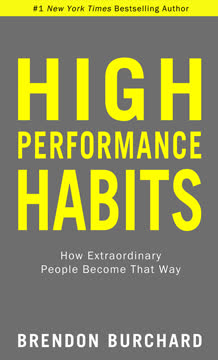Key Takeaways
1. Afformations: The Power of Empowering Questions
"If you don't believe your positive statements yet, why not ask a question that will change your life?"
Afformations are empowering questions that assume what you want is already true. Unlike traditional affirmations, which are positive statements that you may not believe, Afformations leverage your brain's automatic search function to find answers that support your desired reality. This approach helps bridge the gap between your current perceived reality and your new desired reality.
Examples of Afformations:
- Why am I so successful?
- Why do I have enough money?
- Why is it so easy for me to lose weight?
By consistently asking these empowering questions, you train your mind to focus on possibilities and solutions rather than limitations and problems. This shift in focus can lead to profound changes in your thoughts, beliefs, and ultimately, your actions and results.
2. The D.B.A.R. Cycle: Desire, Belief, Action, Result
"Everything we do springs forth from a seed of desire."
The D.B.A.R. Cycle explains how our desires, beliefs, actions, and results are interconnected. It starts with desire, which forms the basis of our goals. Our beliefs about whether we can achieve those desires influence the actions we take. These actions, in turn, lead to results, which reinforce our beliefs.
Key components of the D.B.A.R. Cycle:
- Desire: What you want to achieve or experience
- Belief: Your conviction about whether you can achieve your desire
- Action: The steps you take based on your beliefs
- Result: The outcome of your actions
Understanding this cycle helps you identify where you might be stuck and how to make positive changes. By focusing on empowering beliefs and taking consistent action, you can create a positive feedback loop that leads to better results and reinforces your ability to achieve your desires.
3. Bridging the Belief Gap: From Disempowering to Empowering Questions
"Your life is a reflection of the thought-seeds you plant and give energy to."
The Belief Gap is the space between where you perceive yourself to be now and where you want to be. This gap is often maintained by disempowering questions that reinforce negative beliefs about yourself and your capabilities. By consciously shifting from disempowering to empowering questions, you can begin to bridge this gap.
Steps to bridge the Belief Gap:
- Identify your disempowering questions
- Reverse these questions into empowering ones
- Consistently ask and reflect on your new empowering questions
- Take actions aligned with your new, empowering beliefs
Example transformation:
- Disempowering: "Why am I so broke?"
- Empowering: "Why do I always have enough money?"
By changing the questions you ask yourself, you change the focus of your mind and, consequently, the actions you take and the results you achieve.
4. The Four Steps of The Afformations Method
"The point of Afformations is not to try to trick your mind, but to use it properly."
The Afformations Method consists of four key steps designed to help you leverage the power of empowering questions to transform your life:
- Ask yourself what you want
- Form a new question that assumes what you want is already true
- Accept the truth of your new questions
- Take new actions based on your new assumptions about life
This method helps you:
- Clarify your goals and desires
- Shift your focus to positive possibilities
- Reinforce empowering beliefs
- Inspire action aligned with your new beliefs
By consistently applying these steps, you can create a powerful cycle of positive change in your life, addressing both your inner beliefs and your outer actions.
5. Harnessing Your Mind's Automatic Search Function
"Your mind works just like [Google]. When you ask yourself a question—whether empowering or disempowering—your mind automatically begins to search for the answer."
Your brain is wired to seek answers to questions, a function known as the "embedded presupposition factor." This automatic search function can work for or against you, depending on the questions you ask yourself. By consciously choosing empowering questions, you can direct your mind to focus on solutions and possibilities rather than problems and limitations.
Ways to leverage your mind's automatic search function:
- Consistently ask empowering questions
- Use iAfform Audios to reinforce positive questions
- Write down your Afformations in a journal
- Share your Afformations with supportive friends or family
By harnessing this innate mental function, you can reprogram your subconscious mind to support your goals and desires, leading to more positive thoughts, emotions, and actions.
6. Overcoming Fear and Bad Habits with Afformations
"Fear is the anticipation of pain."
Fear and bad habits often stem from disempowering beliefs and questions. By using Afformations, you can address the root cause of these issues and create new, empowering patterns of thought and behavior.
Strategies for using Afformations to overcome fear and bad habits:
- Identify the specific fear or habit you want to address
- Create empowering questions that assume you've already overcome the issue
- Consistently ask these questions, especially when facing triggers
- Take small, aligned actions to reinforce your new beliefs
Example Afformations for overcoming fear:
- "Why am I so confident?"
- "Why do I feel safe to express Who I Really Am?"
- "Why is it so easy for me to take action despite my fears?"
Remember that overcoming fear and changing habits is a process. Combine Afformations with consistent action for the best results.
7. Transforming Your Life Through Positive Opinions and Assumptions
"When your opinion of your past, present, and future tends to be positive, you will be happy."
Your life experience is shaped by your opinions and assumptions about your past, present, and future. By consciously choosing to form positive opinions and assumptions, you can significantly impact your happiness and overall life satisfaction.
Areas to focus on:
- Past: Reframe negative experiences as learning opportunities
- Present: Appreciate and focus on the abundance in your current life
- Future: Cultivate optimism and belief in positive possibilities
Use Afformations to reinforce positive opinions in each area:
- "Why did everything in my past happen for my highest good?"
- "Why am I so grateful for my life right now?"
- "Why is my future filled with amazing opportunities?"
By consistently asking these types of questions, you can shift your focus and create a more positive, empowering narrative for your life.
8. Applying Afformations to Major Life Areas
"Use these new, empowering Afformations to challenge your assumptions, change your opinions, improve your beliefs, and shift what you focus on . . . and let yourself live the life you've always imagined!"
Afformations can be applied to all major areas of life to create positive change and achieve your goals. By tailoring your Afformations to specific life areas, you can address your unique challenges and aspirations.
Key life areas to focus on:
- Health and Well-Being
- Money and Abundance
- Self-Confidence
- Work and Career
- Love and Relationships
- Family and Relationships
- Spirituality
- Life Purpose and Happiness
For each area, create specific Afformations that align with your goals and desired outcomes. Consistently ask these questions, write them down, and listen to them through iAfform Audios. Combine your Afformations practice with aligned actions to create lasting positive change in all aspects of your life.
Last updated:
FAQ
What's "The Book of Afformations" about?
- Purpose: "The Book of Afformations" by Noah St. John introduces a method called Afformations, which are empowering questions designed to help individuals achieve abundant health, wealth, love, and happiness.
- Concept: Unlike traditional affirmations, which are positive statements, Afformations are questions that assume the desired outcome is already true, prompting the brain to search for answers and solutions.
- Structure: The book is divided into parts that explain the concept of Afformations, provide a step-by-step method to create them, and offer specific Afformations for various areas of life.
Why should I read "The Book of Afformations"?
- Unique Approach: It offers a fresh perspective on personal development by focusing on questions rather than statements, which can be more effective for those who struggle with traditional affirmations.
- Practical Application: The book provides actionable steps and real-life success stories, making it easy for readers to apply the method to their own lives.
- Comprehensive Coverage: It addresses multiple areas of life, including health, wealth, relationships, and self-confidence, providing a holistic approach to personal growth.
What are the key takeaways of "The Book of Afformations"?
- Afformations Method: The book introduces a four-step method: Ask, Afform, Accept, and Act, which helps bridge the gap between current beliefs and desired outcomes.
- Belief Gap: It highlights the importance of addressing the Belief Gap, the space between current perceived reality and new desired reality, which often hinders success.
- Empowering Questions: By changing disempowering questions to empowering ones, individuals can shift their mindset and attract positive results.
How do Afformations differ from traditional affirmations?
- Question vs. Statement: Traditional affirmations are positive statements, while Afformations are questions that assume the desired outcome is already true.
- Mind's Response: Afformations leverage the brain's automatic search function, prompting it to find answers and solutions, whereas affirmations may not be believed if there's a significant Belief Gap.
- Effectiveness: For many, Afformations can be more effective because they align with the natural way the mind processes information, leading to more profound changes.
What is the Afformations Method?
- Four Steps: The method consists of four steps: Ask (identify what you want), Afform (create empowering questions), Accept (embrace the truth of these questions), and Act (take actions based on new assumptions).
- Purpose: It aims to help individuals overcome the Belief Gap and manifest their desires by changing their internal dialogue.
- Application: The method is designed to be simple and applicable to various areas of life, from personal relationships to career success.
What are some examples of Afformations?
- Health: "Why am I so healthy?" or "Why do I love my body?"
- Wealth: "Why am I so rich?" or "Why does money come to me so easily?"
- Self-Confidence: "Why am I so confident?" or "Why do I love being Who I Really Am?"
- Relationships: "Why am I so loved?" or "Why do I have the most incredibly loving relationship with the man of my dreams?"
How can Afformations improve my life?
- Mindset Shift: By changing the questions you ask yourself, you can shift your mindset from scarcity to abundance, leading to more positive outcomes.
- Increased Confidence: Afformations can help build self-confidence by reinforcing positive beliefs about oneself and one's abilities.
- Goal Achievement: They can make it easier to achieve goals by aligning your subconscious mind with your conscious desires, reducing internal resistance.
What are the best quotes from "The Book of Afformations" and what do they mean?
- "You create your life by the statements you say to yourself and others and by the questions you ask yourself and others." This emphasizes the power of both affirmations and Afformations in shaping one's reality.
- "The quality of your life depends on just two things: the quality of your communication with the world inside of you, and the quality of your communication with the world outside of you." It highlights the importance of internal and external dialogue in determining life quality.
- "If you want to live the life of your dreams, change your opinion of your past, your present, and your future." This quote underscores the transformative power of changing one's perspective.
How do I create my own Afformations?
- Identify Desires: Start by asking yourself what you really want in different areas of your life.
- Form Questions: Create questions that assume these desires are already true, such as "Why am I so successful?"
- Embrace and Act: Accept these questions as true and take actions that align with your new beliefs.
What is the Belief Gap and how does it affect success?
- Definition: The Belief Gap is the space between your current perceived reality and your new desired reality.
- Impact: It often prevents individuals from achieving their goals because they don't truly believe they can reach them.
- Solution: Afformations help bridge this gap by changing the underlying beliefs that hold people back.
How can I apply Afformations to my career?
- Identify Career Goals: Determine what you want to achieve in your career, such as a promotion or a new job.
- Create Career Afformations: Form questions like "Why am I so successful in my career?" or "Why do I love my job?"
- Take Action: Use these Afformations to guide your actions and decisions, helping you stay focused and motivated.
What are some real-life success stories from using Afformations?
- Weight Loss: Cecelia used Afformations to lose 163 pounds and improve her health.
- Career Success: George increased his income tenfold and improved his family life by using Afformations.
- Overcoming Fear: A singer-songwriter overcame her fear of financial instability and returned to her passion for music through Afformations.
Review Summary
The Book of Afformations receives mixed reviews, with an average rating of 3.99 out of 5. Many readers find the concept of reframing affirmations as questions intriguing and potentially effective. Positive reviews praise the book's simplicity and practical approach, while critical reviews cite repetitiveness and promotional content as drawbacks. Some readers appreciate the unique perspective on positive thinking, while others feel it lacks depth or scientific backing. Overall, the book seems to resonate with those seeking a fresh approach to self-improvement.
Similar Books









Download PDF
Download EPUB
.epub digital book format is ideal for reading ebooks on phones, tablets, and e-readers.




